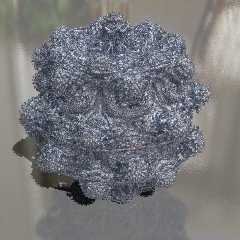|
 |
Warp <war### [at] tag povray povray org> wrote:
> PM 2Ring wrote:
> > How do you turn a df3 density file into a mesh?
>
> You don't turn a df3 density file into a mesh. You calculate a mesh
> from the original fractal.
>
> (Granted, it's not a trivial task, requiring using something like the
> marching triangles algorithm, but still beneficial in terms of rendering
> speed.)
Thanks, Warp.
I found the Marching Cubes C code (cunningly disguised as C++ code...) in p.b.u.
It
converts 8 bit df3 files ok, but of course the resulting mesh isn't quite as
accurate as a POV isosurface. The mesh renders much faster, but it does take
more memory & is much slower to render. So for some applications (eg a lot of
small renders for an animation) I prefer to use the isosurface.
Maybe I need to use the df3 file more efficiently. Currently, I'm only storing 1
bit per voxel: 0 if it's not in the Mandelbulb, 255 if it is. I'm wondering if
there's a better way.
Someone mentioned earlier about doing a glass Mandelbulb. I don't know if this
would work very well, since the surface is fractally bumpy. I've done a glassy
doesn't look very shiny; as you can see below, it's more like a scrunched up
ball of foil. org> wrote:
> PM 2Ring wrote:
> > How do you turn a df3 density file into a mesh?
>
> You don't turn a df3 density file into a mesh. You calculate a mesh
> from the original fractal.
>
> (Granted, it's not a trivial task, requiring using something like the
> marching triangles algorithm, but still beneficial in terms of rendering
> speed.)
Thanks, Warp.
I found the Marching Cubes C code (cunningly disguised as C++ code...) in p.b.u.
It
converts 8 bit df3 files ok, but of course the resulting mesh isn't quite as
accurate as a POV isosurface. The mesh renders much faster, but it does take
more memory & is much slower to render. So for some applications (eg a lot of
small renders for an animation) I prefer to use the isosurface.
Maybe I need to use the df3 file more efficiently. Currently, I'm only storing 1
bit per voxel: 0 if it's not in the Mandelbulb, 255 if it is. I'm wondering if
there's a better way.
Someone mentioned earlier about doing a glass Mandelbulb. I don't know if this
would work very well, since the surface is fractally bumpy. I've done a glassy
doesn't look very shiny; as you can see below, it's more like a scrunched up
ball of foil.
Post a reply to this message
Attachments:
Download 'mandelbulbi5s90.jpg' (160 KB)
Preview of image 'mandelbulbi5s90.jpg'

|
 |




![]()